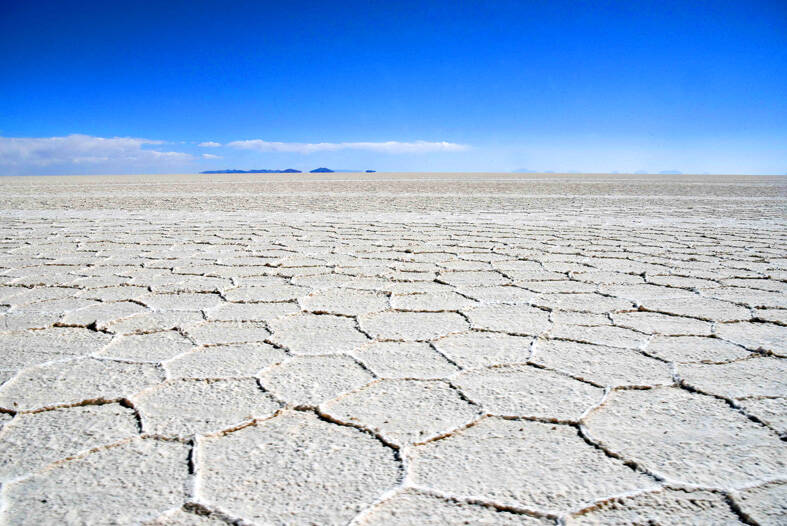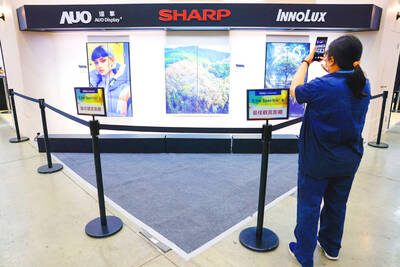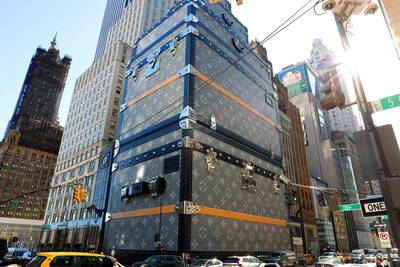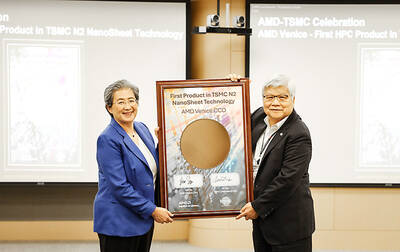In a patch of South America rich in lithium, used to make batteries for electric cars and other tech, Bolivia is lagging its neighbors in the race to mine the key metal.
An area called the “lithium triangle” which spills over the borders of Bolivia, Chile and Argentina is home to 60 percent of the world’s lithium reserves, according to the US Geological Survey.
Bolivia claims to have Earth’s largest deposit of the metal, used to make rechargeable batteries for smartphones, laptops and other devices besides e-vehicles.

Photo: AFP
However, Bolivia has undertaken only four pilot projects and is running just one plant to produce the metal — and at 20 percent of its capacity.
“The next step was going to be taking this up to an industrial level. And this has not been achieved so far,” Bolivian Center for Documentation and Information researcher Gonzalo Mondaca said.
Last year, Bolivia produced 948 tonnes of lithium carbonate, a white salt that is a precursor to the compounds used in lithium-ion batteries, according to the Bolivian Ministry of Mining and Metallurgy.
Based on US estimates, that is one-10th of what Argentina extracted from the earth and just two percent of the haul in Chile, the world’s largest producer after Australia.
“The term lithium triangle is confusing, because it suggests that the area is homogenous,” said Martin Obaya, a researcher at San Martin National University in Argentina. “But it varies from one country to the next and one region to the next.”
In South America, lithium lies in salt flats. The cheapest way to extract it is to pump water up from underground deposits and let it sit in pools to evaporate, leaving the lithium carbonate from which the metal is derived.
In Chile, where the lithium is found in the Atacama Desert, engineers can dig down dozens of meters into the salt flats.
However, this is not possible at Bolivia’s Uyuni salt flat, the world’s biggest, which lies at an altitude of 3,600m.
There, crews can bore down only about 11m, as below that the soil is too compact and it is impossible to pump water up to the surface, Mondaca said.
In December last year, the Bolivian government opened a plant that was supposed to yield 15,000 tonnes per year of lithium carbonate using the evaporation technique. However, the plant did not work properly, and it is now operating at only 20 percent capacity.
“There will always be debate over whether we are facing a window of opportunity that is about to close. It is hard to say, but the project’s performance is frustrating, given the expectations,” Obaya said.
Over the past few months Bolivia raised hopes by signing two contracts for the construction of plants using electro-chemical processes to extract lithium.
This method requires less water but a larger investment up front.
The state lithium company YLB said that with the new technique, producing 1 tonne of lithium at the Uyuni facility would cost US$4,000 to US$8,000, compared with US$2,500 to US$4,000 in Chile.
This year Bolivia signed a deal with a Russian company named Uranium One to build a plant designed to extract 14,000 tonnes of lithium per year.
It also signed a contract with a subsidiary of the Chinese company CATL — the world’s largest battery manufacturer — to set up two lithium extraction sites with a joint capacity of 35,000 tonnes a year.
Both contracts require approval from the Bolivian congress, where the ruling party’s majority is divided between supporters of President Luis Arce and those who back former president Evo Morales. These former allies are now sworn enemies.
Mondaca said Bolivia is simply not prepared for this big lithium challenge “at the technical, legal and institutional level.”
Twenty or 30 years from now Bolivia would be able to produce a lot of lithium, said Gustavo Lagos, a professor at Catholic University in Chile.
But it needs cheaper technology and “we are not there yet,” he added.
The government said Bolivia has the world’s largest lithium resources, but has never stated how much of it can be extracted.
“If the government of Bolivia has succeeded in anything it was in propaganda. It has kept people’s hopes up for more than 15 years,” Mondaca said.

TAKING STOCK: A Taiwanese cookware firm in Vietnam urged customers to assess inventory or place orders early so shipments can reach the US while tariffs are paused Taiwanese businesses in Vietnam are exploring alternatives after the White House imposed a 46 percent import duty on Vietnamese goods, following US President Donald Trump’s announcement of “reciprocal” tariffs on the US’ trading partners. Lo Shih-liang (羅世良), chairman of Brico Industry Co (裕茂工業), a Taiwanese company that manufactures cast iron cookware and stove components in Vietnam, said that more than 40 percent of his business was tied to the US market, describing the constant US policy shifts as an emotional roller coaster. “I work during the day and stay up all night watching the news. I’ve been following US news until 3am

UNCERTAINTY: Innolux activated a stringent supply chain management mechanism, as it did during the COVID-19 pandemic, to ensure optimal inventory levels for customers Flat-panel display makers AUO Corp (友達) and Innolux Corp (群創) yesterday said that about 12 to 20 percent of their display business is at risk of potential US tariffs and that they would relocate production or shipment destinations to mitigate the levies’ effects. US tariffs would have a direct impact of US$200 million on AUO’s revenue, company chairman Paul Peng (彭雙浪) told reporters on the sidelines of the Touch Taiwan trade show in Taipei yesterday. That would make up about 12 percent of the company’s overall revenue. To cope with the tariff uncertainty, AUO plans to allocate its production to manufacturing facilities in

Six years ago, LVMH’s billionaire CEO Bernard Arnault and US President Donald Trump cut the blue ribbon on a factory in rural Texas that would make designer handbags for Louis Vuitton, one of the world’s best-known luxury brands. However, since the high-profile opening, the factory has faced a host of problems limiting production, 11 former Louis Vuitton employees said. The site has consistently ranked among the worst-performing for Louis Vuitton globally, “significantly” underperforming other facilities, said three former Louis Vuitton workers and a senior industry source, who cited internal rankings shared with staff. The plant’s problems — which have not

COLLABORATION: Given Taiwan’s key position in global supply chains, the US firm is discussing strategies with local partners and clients to deal with global uncertainties Advanced Micro Devices Inc (AMD) yesterday said it is meeting with local ecosystem partners, including Taiwan Semiconductor Manufacturing Co (TSMC, 台積電), to discuss strategies, including long-term manufacturing, to navigate uncertainties such as US tariffs, as Taiwan occupies an important position in global supply chains. AMD chief executive officer Lisa Su (蘇姿丰) told reporters that Taiwan is an important part of the chip designer’s ecosystem and she is discussing with partners and customers in Taiwan to forge strong collaborations on different areas during this critical period. AMD has just become the first artificial-intelligence (AI) server chip customer of TSMC to utilize its advanced